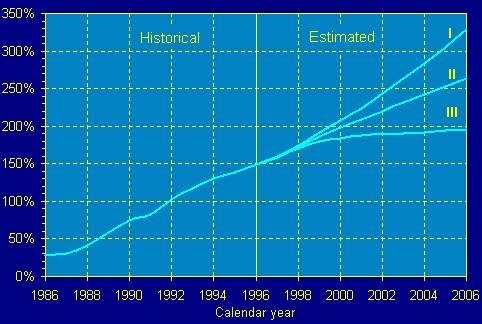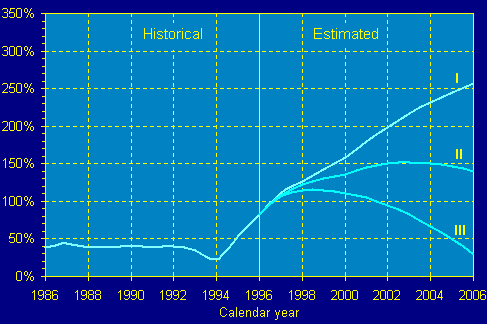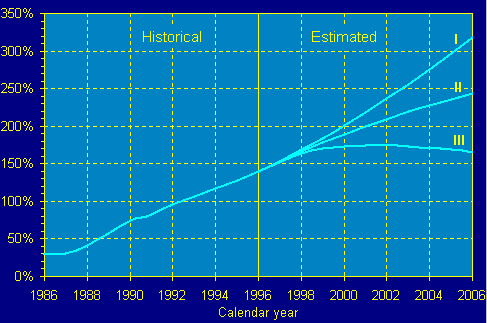Figure I.G1.OASI Trust Fund Ratios
[Assets as a percentage of annual expenditures]
For example, OASDI assets at the beginning of calendar year 1997 amounted to $567 billion, while assets at the beginning of 1960 were $22 billion. The asset level in 1997 would be sufficient to cover roughly 18 months of expenditures in the absence of other income. Assets in 1960, although much smaller in nominal dollars, could have covered about 22 months of expenditures and thus represented a somewhat stronger contingency reserve.
The ratio of trust fund assets at the beginning of a year to expenditures during the year is termed the "trust fund ratio." This ratio serves as the primary measure of the fund's financial adequacy in the short range. It is also used when applying an explicit test of short-range financial adequacy.
As shown in figure I.G1, the OASI trust fund ratio is estimated to increase from 160 percent at the beginning of 1997 to 264 percent by 2006, based on the intermediate (alternative II) assumptions. The ratio is also estimated to increase during the next 10 years under the low cost (alternative I) assumptions. However, under the high cost (alternative III) assumptions the ratio is estimated to level off by 2006. Because OASI assets are estimated to exceed 100 percent of annual expenditures throughout the next 10 years, the OASI Trust Fund meets the requirements of the Trustees' formal test of short-range financial adequacy. (This test is described in detail in the section entitled "Actuarial Estimates" later in this report.) Thus, the financing scheduled under present law for the OASI Trust Fund is considered fully adequate to meet future expenditures over this period and to provide for an adequate contingency reserve.
Figure I.G1.OASI Trust Fund Ratios[Assets as a percentage of annual expenditures] |

|
However, as also shown in figure I.G2, under the high cost assumptions, not only does DI fail to meet the short-range test of financial adequacy, the DI Trust Fund is projected to be exhausted soon after the end of the short-range projection period. This situation is similar to projections made for the 1996 Annual Report.
Figure I.G2.DI Trust Fund Ratios[Assets as a percentage of annual expenditures] |

|
Figure I.G3.Trust Fund Ratios for OASI and DI Trust Funds, Combined[Assets as a percentage of annual expenditures] |

|
As shown, the trust fund ratio for OASI and DI on a combined basis is
estimated to increase from 153 percent at the beginning of 1997 to 244
percent by 2006, based on the intermediate assumptions. Based on
the low cost assumptions, the ratio would also increase throughout
the 10-year period. Under the high cost assumptions, however, the
ratio would be lower at the beginning of 2002, and each year thereafter, than it was at the beginning of the previous year (but would
remain above 100 percent throughout the short-range period).
Because the trust fund ratio for the combined funds is estimated to
remain above 100 percent under the intermediate assumptions, the
combined funds meet the short-range test of financial adequacy.